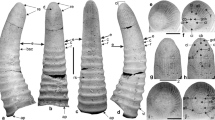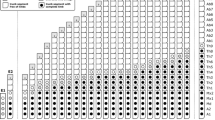Abstract
Rhabdopleura compacta (Hineks) has a motile larva. It is evenly ciliated, and swims by rotating about its long axis. The larva is lecithotrophic, and contains a considerable amount of yolk within the blastocoel. The blastocoel is lined with a layer of flattened cells early in development, before gastrulation has begun. The endoderm is formed by invagination. Initially, the endoderm cells are tall, columnar, and contain much yolk. Nerve fibres can be seen amongst the ectoderm cells very early in development. The ectoderm cells are separated from the inner layers and yolk by a basement lamella. There is yolk within the cells as well as in the blastocoel. Some of the yolk within the blastocoelic cavity is contained within cells and some of it is extracellular. The larvae settle during gastrulation, attaching themselves to the substratum. They tend to settle in the highest parts of upturned, empty, lamellibranch shells. Soon afterwards the body regions of the adult become recognisable.
Similar content being viewed by others
Literature Cited
Andersson, K. A.: Eine Wiederentdeckung von Cephalodiscus. Zool. Anz. 26, 368–369 (1903)
—: Die Pterobranchier der Schwedischen Südpolar-Expedition 1901–1903. Wiss. Ergebn. schwed. Südpolarexped. 5, 1–122 (1907)
Burdon-Jones, C.: The habitat and distribution of Rhabdopleura normani (Allman). Univ. Bergen Årb. (Natur. rekke) 11, 1–17 (1954)
—: The biology of Rhabdopleura normani Allman. Rep. Challenger Soc. 3, p. 9 (1957)
Clark, R. R.: Dynamics and metazoan evolution. 313 pp. Oxford: Clarendon Press 1964
Cowles, R. P.: Origin and fate of the body cavities and the nephridia of the Actinotrocha. Johns Hopkins Univ. Circ. (New Ser.) 23 (167), 28–37 (1904)
Dilly, P. N.: Electron microscope observations of the receptors in the sensory vesicle of the ascidian tadpole. Nature, Lond. 191, 786–787 (1961)
—: Studies on the receptors in the cerebral vesicle of the ascidian tadpole. I. The otolith. Q. Jl microsc. Sci. 103, 393–398 (1962)
—: The nerve fibres in the basement membrane and related structures in Saccoglossus horsti (Enteropneusta). Z. Zellforsch. mikrosk. Anat. 97, 69–83 (1969)
—: The structure of the tentacles of Rhabdopleura compacta (Hemichordata) with special reference to neurociliary control. Z. Zellforsch. mikrosk. Anat. 129, 20–39 (1972)
Gilchrist, J. D. F.: On the development of Cape Cephalodiscus (C. gilchristi Ridewood). Q. Jl microsc. Sci. 62, 189–212 (1917)
Gray, E. G.: Tissue of the central nervous system. In: Electron microscopic anatomy, pp 369–417. Ed. by S. M. Kurtz. London: Academic Press 1964
Harmer, S. F.: The Pterobranchia of the Siboga-Expedition. Siboga Exped. Monogr. 26, 1–131 (1905)
Hyman, L. H.: The invertebrates, V. 783 pp. London: McGraw-Hill 1959
John, C. C.: On the development of Cephalodiscus. ‘Discovery’ Rep. 6, 193–204 (1932)
Lankester, E. R.: A contribution to the knowledge of Rhabdopleura. Q. Jl microsc. Sci. 24, 622–647 (1884)
Masterman, A. T.: On the further anatomy and budding process of Cephalodiscus dodecalophus. Trans. R. Soc. Edinb. 19, 507–527 (1898)
Nørrevang, A.: The position of Pogonophora in the phylogenetic system. Z. zool. Syst. Evolutionsforsch. 8, 161–172 (1970)
Reynolds, E. S.: The use of lead citrate at high pH as an electron opaque stain for electron microscopy. J. Cell Biol. 17, 208–212 (1963)
Ridewood, W. G.: Pterobranchia: Cephalodiscus. ‘Discovery’ Rep. 2, 1–67 (1907)
Schepotieff, A.: Die Pterobranchier des Indischen Ozeans Zool. Jb. (Abt. Syst. Ökol. Tiere) 28, 429–448 (1909)
Selys Longchamps, M. de: Phoronis. Fauna und Flora des Golfes van Neapel. Monogr., 30, 1–280 (1907)
Stebbing, A. R. D.: Discovery of Rhabdopleura (Hemichordata) at Plymouth. Nature, Lond. 217, p. 1284 (1968)
—: Aspects of the reproduction and life cycle of Rhabdopleura compacta (Hemichordata). Mar. Biol. 5, 205–212 (1970a)
—: The status and ecology of Rhabdopleura compacta (Hemichordata) from Plymouth. J. mar. biol. Ass. U.K. 50, 209–221 (1970b)
Tilney, L. G.: Ordering of subcellular units II. Devl Biol. (Suppl.) 2, 63–102 (1968)
Author information
Authors and Affiliations
Additional information
Communicated by J. H. S. Blaxter, Oban
Rights and permissions
About this article
Cite this article
Dilly, P.N. The larva of Rhabdopleura compacta (Hemichordata). Marine Biology 18, 69–86 (1973). https://doi.org/10.1007/BF00347923
Accepted:
Issue Date:
DOI: https://doi.org/10.1007/BF00347923




